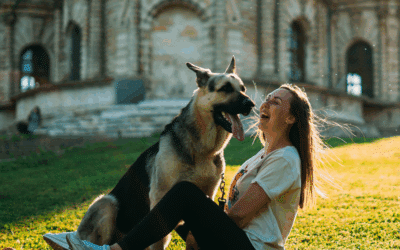Disclaimer: Kate’s K9 Pet Care proudly provides dog walking, cat sitting, small animal pet care, pet taxi services, “Almost Overnight” pet care, and convenient pet supply delivery.
For full details about each of our services, please visit our Service Pages to learn more about how we can support your pet’s needs. To see where we currently operate, please visit our Service Area Page.
Are you wanting to learn facts about dogs?
Dogs are truly remarkable animals and have earned their spot as humans’ best friend over the centuries. From their incredible sense of smell to their diverse breeds, these loyal companions have countless traits and stories that make them fascinating.
Whether you’re a proud dog owner or simply an animal lover, here’s a deep look into some of the coolest facts about dogs.
Need Pet Care Fast?
Submit an Instant Service Request today and we’ll take care of the rest.

Dogs Are the Most Popular Pet in the World
It’s no surprise that dogs, scientifically known as Canis lupus familiaris, are the most popular pets worldwide. They provide companionship, protection, and even serve functional roles like police dogs or assistance dogs. Their loyal and loving nature sets them apart from other animals, like cats, as they seem to form a deeper bond with their owners.
The Evolution of Dogs
From Wolves to Pups on Your Couch
Dogs originated from gray wolves (Canis lupus), and their domestication began around 15,000 years ago. This process of domestication was likely fueled by mutual benefits for humans and wolves, like protection and food. Selective breeding further diversified them into the various breeds we have today, from the towering Great Dane to the tiny Chihuahua.
Incredible Facts About Dog Breeds
Endless Diversity
There are more than 340 recognized dog breeds worldwide, each created through centuries of selective breeding. From agile Greyhounds and spirited Terriers to intelligent Standard Poodles, every breed has unique characteristics and traits.
Purebred Dogs vs. Mixed Breeds
Purebred dogs have consistent characteristics due to controlled breeding, but mixed-breed rescue dogs often tend to be healthier, as their varied genetic pool reduces hereditary diseases.
Dogs’ Extraordinary Senses
Dogs Noses Like No Other
Did you know that each dog’s nose is as unique as a human fingerprint? It’s true! The nose print of every dog is different, making it possible to identify them in the same way we identify humans. On top of that, a dog’s sense of smell is about 10,000 to 100,000 times sharper than a human’s. This incredible sense has made dogs essential as police and working dogs, sniffing out drugs, missing persons, and even medical conditions like cancer.
Dogs’ Eyes and Ears
Dogs see the world differently than humans. While they don’t rely on color vision as much, they have a third eyelid, which helps protect and moisten their eyes. Many dogs also “hear” their surroundings better than humans, picking up sounds we can’t perceive.
Quirky Traits That Make Dogs Special
- Dogs sweat through their paws. Unlike humans, dogs don’t sweat from their bodies. Instead, they regulate their temperature by panting and through the sweat glands on their paws.
- Some dogs have black tongues. While this is most commonly associated with the Chow Chow and Shar-Pei, many other dogs can naturally have black or spotted tongues.
- Right-pawed or left-pawed. Much like humans, dogs can favor their right or left paw. Studies have shown that many dogs display a clear preference when engaging with objects.
The Social Nature of Dogs
A Family-Oriented Species
Dogs are incredibly social animals, whether interacting with humans or other dogs. They thrive in “packs,” which explains why dog ownership creates such a strong bond between humans and their furry companions. Domestic dogs view their owners as part of their family unit, engaging with them in ways that are remarkably similar to their interactions with other dogs in a pack setting.
Dogs as Heroes and Helpers
Assistance Dogs
Assistance dogs are specially trained to support individuals with disabilities, enhancing their independence and quality of life. These remarkable animals perform a wide range of tasks tailored to their handler’s specific needs and are categorized into several types:
Guide Dogs
Guide dogs help individuals with visual impairments safely navigate their environment. They are trained to avoid obstacles, stop at curbs, and ensure their handler’s safety while crossing streets. Their dedication allows people with vision loss to move about with confidence and freedom.
Hearing Dogs
Hearing dogs are trained to assist those who are deaf or hard of hearing by alerting their handler to essential sounds such as doorbells, alarms, or a baby’s cry. These dogs ensure their handler stays informed about their surroundings, improving safety and communication.
Medical Alert Dogs
Medical alert dogs can detect changes in their handler’s body chemistry, often recognizing medical conditions like low blood sugar, seizures, or even heart irregularities before they occur. They provide crucial support by alerting their handler or others, allowing timely action to prevent emergencies.
Mobility Assistance Dogs
For individuals with physical disabilities, mobility assistance dogs help by retrieving objects, opening doors, or providing balance and stability. These dogs empower their handlers by assisting with tasks that might otherwise be difficult or impossible to accomplish alone.
Psychiatric Service Dogs
Psychiatric service dogs provide support to individuals with mental health challenges such as PTSD, anxiety, or depression. They can help by offering calming pressure during moments of distress, interrupting harmful behaviors, or guiding their handler away from triggering situations.
Assistance dogs undergo rigorous training to ensure they can perform their jobs reliably and adapt to a variety of environments. Beyond their practical skills, these dogs also offer companionship and emotional support, forming an unbreakable bond with their handlers. By recognizing and valuing the work of assistance dogs, we not only celebrate their extraordinary abilities but also the profound effect they have on the lives of those they serve.
Fun Facts Dog Owners May Not Know
- Dogs lived alongside humans for millennia. Evidence shows that dogs have played a role in human societies since ancient times.
- Dogs engage with humans through eye contact. Maintaining eye contact with your dog releases oxytocin (the love hormone) for both you and them!
- Puppies are born blind and deaf. Newborn dogs rely entirely on their sense of smell and touch to find their way to their mom and their first meal.
Wild and Feral Dogs
Though domesticated dogs are part of our families, not all dogs live in these conditions. Some feral dogs, which revert to their wild state, survive through natural selection, adapting remarkably to new environments. These dogs often form packs and have to fend for themselves, showcasing survival skills that domesticated dogs no longer rely on.
Amazing Facts About Small Dogs and Large Dogs Small dogs live longer. On average, smaller breeds such as Terriers and Toy Poodles outlive their larger counterparts by several years.
- Large breeds can weigh over 100lbs. Giant breeds like Great Danes are gentle giants, but their size means they have different nutritional needs and a shorter lifespan.
- Greyhounds are the “cheetahs” of dogs. These sleek racers can hit speeds of up to 45 mph, earning their standing as one of the fastest land animals.
Common Myths About Dogs
Dogs have been our loyal companions for so long that numerous myths have developed around them over the years.
While some of these myths come from well-meaning sources, others may lead to misunderstandings about our furry friends. Here are some common myths about dogs debunked:
Myth: Dogs see only in black and white.
Reality: While dogs don’t see the full spectrum of colors like humans, they are not limited to black and white vision. Dogs perceive colors in shades of blue and yellow, similar to a person with red-green color blindness.
Myth: A wagging tail always means a happy dog.
Reality: Tail wagging can indicate excitement, but not all tail wags are friendly. Dogs may wag their tails when they are agitated, nervous, or even aggressive. Pay attention to their overall body language to interpret their mood.
Myth: Dogs age 7 years for every human year.
Reality: This rule of thumb oversimplifies canine aging. A dog’s size, breed, and health factors play a more significant role in determining their aging process. For instance, smaller breeds tend to live longer than larger ones.
Myth: Dogs eat grass when they feel sick.
Reality: While some dogs may eat grass to soothe an upset stomach, others do it simply because they enjoy the taste or texture. Observing why your dog eats grass can help you better understand their behavior.
Myth: You can’t teach an old dog new tricks.
Reality: Dogs are capable of learning at any age. With patience, consistency, and positive reinforcement, even older dogs can pick up new behaviors and skills.
Understanding the truth behind these myths helps ensure that we provide the care and attention our dogs deserve while strengthening the bond we share with them. Don’t hesitate to dig deeper into the fascinating world of canine behaviors to truly appreciate these incredible animals.
Beyond Companion Animals
Dogs aren’t just pets; they’re essential partners for numerous jobs, from hunting and search-and-rescue tasks to working alongside police or military personnel. Their loyalty and adaptability mean that dogs can be trained to accomplish almost anything.
Useful Resources and Links About Dogs
- American Kennel Club (AKC) – A trusted resource for information on dog breeds, training tips, and health advice.
- The Humane Society of the United States – Provides education about responsible pet ownership, adoption resources, and animal welfare advocacy.
- ASPCA – Offers resources on pet adoption, animal behavior, and safety tips for dogs and their owners.
- Petfinder – A comprehensive resource for finding adoptable dogs and other pets in your local area.
- Dogtime – Features expert advice on dog training, nutrition, and breed information.
- Whole Dog Journal – A publication focused on holistic dog care, including training methods, nutrition, and canine wellness.
- Vetstreet – Offers professional advice on pet health, behavior, and breed information directly from veterinarians.

Kate’s K9 Pet Care loves everything dogs! Everything cats! Everything animals! Visit our site to see what pet services we offer!
Why Dogs Will Always Fascinate Us | Facts About Dogs
Dogs are more than just animals; they’re family members, protectors, and companions that have evolved alongside us for thousands of years.
Whether you’re marveling at their unique traits (like their dog’s nose prints) or enjoying the unconditional love they offer, one thing’s for certain—we couldn’t imagine life without man’s best friend.







